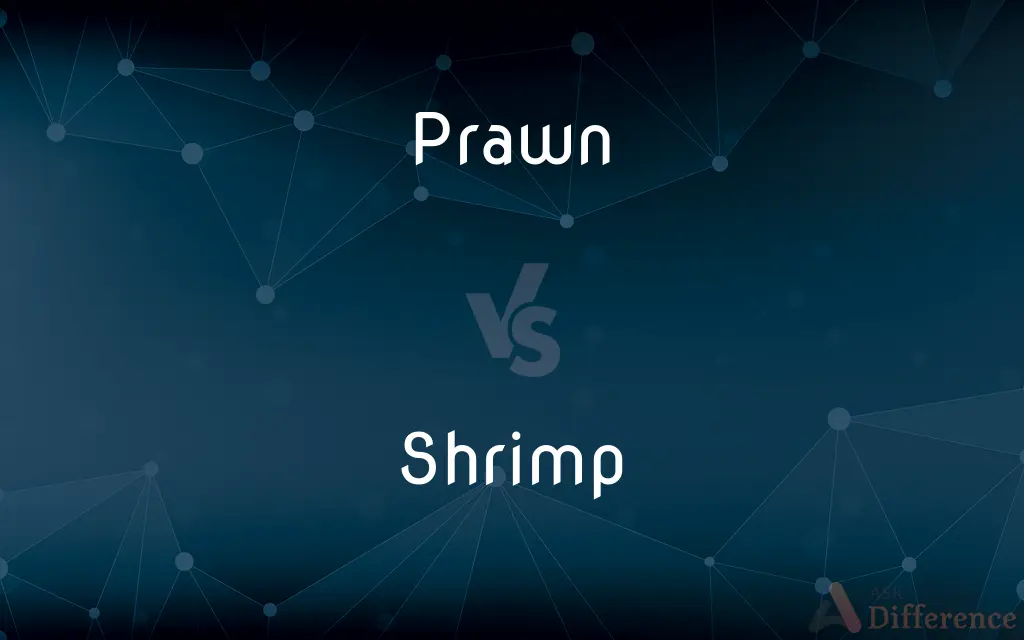Prawn vs. Shrimp — What's the Difference?
By Tayyaba Rehman — Updated on September 22, 2023
Prawns and shrimp are similar aquatic animals, with prawns typically larger; the terms are often used interchangeably, but differences exist in anatomy and biology.

Difference Between Prawn and Shrimp
Table of Contents
ADVERTISEMENT
Key Differences
Prawns and shrimp are crustaceans and, despite their similarities, belong to different suborders—prawns to Dendrobranchiata and shrimp to Pleocyemata. Prawns, generally larger, have a slightly sweeter taste and are a delicacy in many cuisines. They possess a gill structure branching like a tree and have their front pincers usually larger, making them distinct. Their bodies are typically longer and have a less curved form, which distinguishes them from shrimp in culinary applications.
Shrimp, in comparison, are usually smaller and have a more pronounced curve to their bodies. They possess a plate-like gill structure and have the second pair of pincers more prominent. Shrimp are widely consumed and are known for their rich, versatile flavor, compatible with various culinary styles. They serve as a primary ingredient in a variety of dishes, from seafood platters to pasta.
The difference in the size and structure of prawns and shrimp also affects the texture of their meat when cooked. Prawns tend to have a firmer texture due to their larger size and different muscle structure, while shrimp tend to be more delicate. The variation in texture influences the choice between prawns and shrimp in different dishes, with prawns often preferred for grilling and shrimp suitable for mixed dishes.
Despite the biological differences, the terms prawn and shrimp are used interchangeably in many regions, especially in the United States, leading to confusion. The discrepancies in naming often depend on regional dialects, culinary traditions, and local seafood availability. While prawn and shrimp differ scientifically, the distinction is more subtle in everyday language and culinary contexts.
The anatomy, taste, texture, and size differences between prawns and shrimp impact their culinary applications and market availability. Understanding these differences is essential for culinary enthusiasts, chefs, and seafood consumers to make informed choices based on preference, recipes, and regional seafood traditions.
ADVERTISEMENT
Comparison Chart
Size
Generally larger.
Usually smaller.
Taste
Slightly sweeter and delicate.
Rich and versatile.
Texture
Firmer texture due to different muscle structure.
More delicate texture.
Body Shape
Longer and less curved.
More pronounced curve to their bodies.
Gill Structure
Branching like a tree.
Plate-like.
Compare with Definitions
Prawn
Prawns are known for their slightly sweeter and more delicate flavor compared to shrimp.
The grilled prawns tasted wonderfully sweet.
Shrimp
Shrimp serve as a primary ingredient in various dishes.
The shrimp tacos were a delightful mix of flavors.
Prawn
It refers to a variety of species within the suborder Dendrobranchiata.
Different species of prawns inhabit the world’s oceans.
Shrimp
Shrimp are harvested globally and are a significant part of seafood cuisine.
The shrimp bisque had a smooth, creamy texture.
Prawn
Prawns are a popular seafood delicacy in many cuisines.
The spicy prawn curry was a hit at the dinner party.
Shrimp
A shrimp is a small, edible marine crustacean with a curved body.
He tossed the shrimp into the boiling pot.
Prawn
It's a term often used interchangeably with shrimp in culinary contexts.
The prawn cocktail was the starter of choice.
Shrimp
It refers to various species within the suborder Pleocyemata.
Freshwater shrimp are found in inland waters.
Prawn
A prawn is a large, edible, marine crustacean with a slender body and long legs.
The chef added some fresh prawns to the paella.
Shrimp
Shrimp are decapod crustaceans with elongated bodies and a primarily swimming mode of locomotion – most commonly Caridea and Dendrobranchiata. More narrow definitions may be restricted to Caridea, to smaller species of either group or to only the marine species.
Prawn
Prawn is a common name for small aquatic crustaceans with an exoskeleton and ten legs (which is a member of the order decapoda), some of which can be eaten.The term "prawn" is used particularly in the United Kingdom, Ireland, and Commonwealth nations, for large swimming crustaceans or shrimp, especially those with commercial significance in the fishing industry. Shrimp that are present in this category often belong to the suborder Dendrobranchiata.
Shrimp
Any of various small, chiefly marine, often edible decapod crustaceans that have a laterally compressed, elongated body with long antennae and long legs used for swimming. The shrimps include species belonging to the superfamily Penaeoidea of the suborder Dendrobranchiata and to the infraorder Caridea of the suborder Pleocyemata.
Prawn
Any of various shrimps, especially one that is large or inhabits fresh water.
Shrimp
The flesh of one of these crustaceans, used as food.
Prawn
The flesh of a prawn, used as food.
Shrimp
Any of various similar crustaceans, such as a fairy shrimp.
Prawn
To fish for prawns.
Shrimp
Derogatory Slang A person who is small in stature.
Prawn
A crustacean of the suborder Dendrobranchiata.
Shrimp
To fish for shrimp.
Prawn
(Commonwealth) A crustacean, sometimes confused with shrimp.
Shrimp
Any of many swimming, often edible, crustaceans, chiefly of the infraorder Caridea or the suborder Dendrobranchiata, with slender legs, long whiskers and a long abdomen.
Prawn
Synonym of butterface: A woman with an attractive body but an unattractive face.
She's a prawn!
Shrimp
(uncountable) The flesh of such crustaceans.
Prawn
A fool, an idiot.
Shrimp
(slang) A small, puny or unimportant person.
Prawn
Alternative form of porn.
Shrimp
Synonym of butterface: a person with an attractive body but unattractive face.
Prawn
(intransitive) To fish for prawns.
Shrimp
(intransitive) To fish for shrimp.
Prawn
Any one of numerous species of large shrimplike Crustacea having slender legs and long antennæ. They mostly belong to the genera Pandalus, Palæmon, Palæmonetes, and Peneus, and are much used as food. The common English prawn is Palæmon serratus.
Shrimp
To contract; to shrink.
Prawn
Any of various edible decapod crustaceans
Shrimp
To contract; to shrink.
Prawn
Shrimp-like decapod crustacean having two pairs of pincers; most are edible
Shrimp
Any one of numerous species of macruran Crustacea belonging to Crangon and various allied genera, having a slender body and long legs. Many of them are used as food. The larger kinds are called also prawns. See Illust. of Decapoda.
Prawn
Fish for prawns
Shrimp
Figuratively, a little wrinkled man; a dwarf; - in contempt.
This weak and writhled shrimp.
Shrimp
Disparaging terms for small people
Shrimp
Any of various edible decapod crustaceans
Shrimp
Small slender-bodied chiefly marine decapod crustaceans with a long tail and single pair of pincers; many species are edible
Shrimp
Fish for shrimp
Shrimp
It's widely consumed and known for its rich and versatile flavor.
The shrimp scampi was delicious and flavorful.
Common Curiosities
Do prawns have a different texture compared to shrimp?
Yes, prawns usually have a firmer texture, while shrimp are more delicate.
Are prawns preferred in some cuisines over shrimp?
Yes, the choice depends on regional preferences, recipes, and availability.
Is there a significant price difference between prawn and shrimp?
Prices can vary, but prawns are often more expensive due to their size.
Are prawns and shrimp the same?
They are similar but belong to different suborders, and prawns are generally larger.
Is the taste of prawn and shrimp different?
Prawns have a slightly sweeter and more delicate flavor, while shrimp have a rich, versatile taste.
Can prawns and shrimp be used interchangeably in recipes?
Often, yes, but differences in size and texture may affect the final dish.
Share Your Discovery

Previous Comparison
Plier vs. Wrench
Next Comparison
Device vs. DeviseAuthor Spotlight
Written by
Tayyaba RehmanTayyaba Rehman is a distinguished writer, currently serving as a primary contributor to askdifference.com. As a researcher in semantics and etymology, Tayyaba's passion for the complexity of languages and their distinctions has found a perfect home on the platform. Tayyaba delves into the intricacies of language, distinguishing between commonly confused words and phrases, thereby providing clarity for readers worldwide.














































